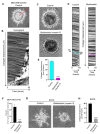Long Prehensile Protrusions Can Facilitate Cancer Cell Invasion through the Basement Membrane
- PMID: 37887318
- PMCID: PMC10605924
- DOI: 10.3390/cells12202474
Long Prehensile Protrusions Can Facilitate Cancer Cell Invasion through the Basement Membrane
Abstract
A basic process in cancer is the breaching of basement-membrane barriers to permit tissue invasion. Cancer cells can use proteases and physical mechanisms to produce initial holes in basement membranes, but how cells squeeze through this barrier into matrix environments is not well understood. We used a 3D invasion model consisting of cancer-cell spheroids encapsulated by a basement membrane and embedded in collagen to characterize the dynamic early steps in cancer-cell invasion across this barrier. We demonstrate that certain cancer cells extend exceptionally long (~30-100 μm) protrusions through basement membranes via actin and microtubule cytoskeletal function. These long protrusions use integrin adhesion and myosin II-based contractility to pull cells through the basement membrane for initial invasion. Concurrently, these long, organelle-rich protrusions pull surrounding collagen inward while propelling cancer cells outward through perforations in the basement-membrane barrier. These exceptionally long, contractile cellular protrusions can facilitate the breaching of the basement-membrane barrier as a first step in cancer metastasis.
Keywords: 3D culture; basement membrane; cell protrusion; collagen; contractility; cytoskeleton; integrin; invasion; myosin II; spheroid.
Conflict of interest statement
The authors declare no conflict of interest.
Figures







References
Publication types
MeSH terms
Substances
Associated data
Grants and funding
LinkOut - more resources
Full Text Sources

